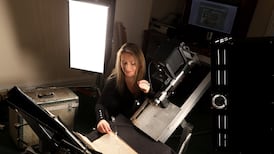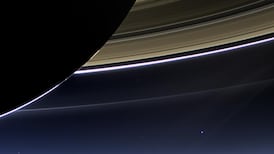Now in its 45th year, the BT Young Scientist Exhibition continues to nurture bright sparks and prepare them for tomorrow's world. ROSITA BOLANDreports...
Prof Luke Drury (above) won in 1969, for a physical chemistry project. He studied physics in Trinity College Dublin, and received his PhD in Astrophysics from Cambridge University. Working as an astrophysicist at the Max Planck Institute of Nuclear Physics in Heidelberg, Drury’s focus was – and is – the research of cosmic rays. He now works at the Dublin Institute for Advanced Studies.
“When I won the Young Scientist, it was an era when there was much less emphasis on publicity. We weren’t used to it. I appeared on national television, and I still vividly remember shaking Brian Lenihan’s hand – he was the Minister for Education at the time.
“Winning the prize didn’t hinder me in my career, but probably the truth is that most of the people who win the top award go on to a career in science anyway. But it was helpful. The most impressive thing about the competition is the consistently high quality of the judging. You are judged as if you’re submitting a PhD. It’s borne out in the success rate winners have when they go on to compete in further competitions, which is phenomenal.
The competition is enormously impressive, and I don’t think schools and the education systems are really capitalising on that. What I mean is that the education system encourages rote learning. At school level, you can’t take the time to do a really good project of the kind done at the exhibition, because you are not going to get exam credit for it. But it’s precisely this kind of imagination and curiosity we need to be fostering. The Young Scientist Exhibition is the best thing the Irish educational system has going for it.”
Catherine Conlon won in 1981 for her project on spiders and their webs. She graduated from UCD with a degree in Medicine and a Masters in Public Health. Conlon worked in general practice, public health and currently lectures in Epidemiology and Public Health at UCC. She recently published the anthology, Sonas, Celtic Thoughts of Happiness.
“I used to go the Young Scientist Exhibition every year with my dad, and I really enjoyed it, and found it so interesting and challenging. I’m not surprised at all that the competition is still running. There was some uncertainty about its future when Aer Lingus dropped the sponsorship, however. But the exhibition is so far forward in its field.
When you walk in the doors of the RDS, there is such energy and creativity. It’s hard to find that elsewhere in an Irish context for students that age – maybe in a sports setting.
“Winning didn’t specially help my career. But it did give me a great confidence in my ability to achieve what I wanted to achieve, and that is something that has followed me through my life, so in that regard, it has had a long influence.”
IT’S THE time of year when unscientifically-minded members of the public marvel at the collective brainpower of the teenagers who showcase their projects at the BT Young Scientist and Technology Exhibition, which opens on Tuesday at the RDS.
The first exhibition was held at the Mansion House in 1965. It was the idea of two physicists working at UCD, Rev Tom Burke and Tony Scott, who were impressed by the science fairs they had seen while working in the US. It was opened by then-taoiseach Sean Lemass and sponsored by what was then called Aer Lingus – Irish International Airlines. The exhibition featured 185 participants. The top prize was £250, won by John Monaghan, an 18-year-old student from Newbridge College, for a project “demonstrating the various chemical reactions that take place in the body during digestion”.
By the following year, there were 366 entrants – the majority of them female – and the exhibition had moved to the RDS. “Where were all the boy scientists?” asked one headline from this paper. “Women taking over field of science?” asked another. The public packed the exhibition, with long queues reported outside the RDS for the duration.
The winner that year was Maire Ní Dhomhnaill from Ursuline Convent in Sligo, described as “a tall pleasant girl” who “seemed to be quite unprepared for the excitement which greeted her exhibit, a learned project on the ‘four colour problem’ in topology, and confessed that one of her main interests was in domestic economy.”
Possibly named for her fellow townsperson and famous writer, a Maria Edgeworth of Edgeworthstown won in 1970, with a project on extracting pigments from flowers. It was a year when there were a number of projects focusing on pollution. That year, sociology had been added as a category. Then-minister for education Pádraig Faulkner commented: “We are going through a great period of social change in Ireland and the improved prospects of joining the Common Market will probably accelerate these changes.”
By 1980, there were 1,200 participants from all counties bar Leitrim. There was an essay about that year's competition in the Irish Naturalists' Journal. The notion of sustainable energy three decades ago was unusual enough to merit this observation: "Many of the young scientists showed a surprising concern to uncover sources of energy for Ireland for future years. Individuals dealt with problems encountered in the utilisation of wind and waves."
THE ARTICLE ALSOpointed out that "Each year . . . girls have outnumbered boys. This interest shown by young women in science augers well for the future of science in Ireland in the years ahead. Women, with their finer appreciation of life and its values, would explore the talents of the nation and would seek to develop the creativity of the workforce."
By the mid-1980s, crowds of more than 30,000 people were visiting the annual exhibition. The core projects have always concentrated on pure science, but there have been plenty of esoteric projects along the way. These have included one on why boys are twice as likely to be bitten by dogs as girls; an automatic dog-washing machine; and a more energy efficient way of cooking potatoes. In 1993, three Cork students presented an elaborate anti-theft bicycle alarm, which rang when a key was inserted in a lock. In the accompanying photograph, the device was pictured as being the size of a computer screen; the students admitted it was still a work in progress. Of the several hundred entries received every year, only 500 projects make it through to the RDS in any one year.
By 1994, when there was a formal reunion of many of the previous winners, only two of them were found to have chosen non-science related careers, a trend which continues. Girls participating in the competition also continue to outnumber boys. Aer Lingus sponsored the competition for 33 years; for the last 10 years, BT have been the sponsors.
The winner who attracted the most publicity was Sarah Flannery, who was 16 when her cryptographic algorithm, the Cayley-Purser, made headlines around the world. She co-wrote a book with her father, David, In Code, A Mathematical Journey, before heading to Cambridge University for a Computer Science degree.
In 2006, Aisling Judge, who was 14 at the time and in second year, became the competition’s youngest winner, with a project on a biological food spoilage indicator. Last year, John D O’Callaghan (14) and Liam McCarthy (13) won for their project which used washing up liquid to establish the health of cattle.
This year, there have been a record number of entrants, with submissions from 32 counties and 329 schools.
Young Scientist in Numbers
329 schools represented
1,588 projects entered
534 entries in Biological and Ecological Sciences
303 entries in Chemical, Physical and Mathematical Sciences
553 entries in Social and Behavioural Sciences
198 entries in Technology
€2,400 Prize for Young Scientist of the Year. The prize also includes the opportunity to represent Ireland at the European Union Contest for Young Scientists
57 Percentage of female entrants
43 Percentage of male entrants
The BT Young Scientist and Technology Exhibition is at the RDS from Tuesday till Saturday 16th btyoungscientist.com











